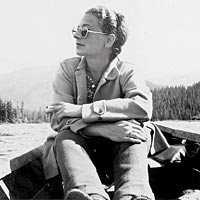|
Photo: Katharine Kuh Papers, 1908-1994, Archives Of American Art, Smithsonian Institution |
| Kuh in 1941 |
In 1937, Katharine Kuh attended an auction of modern art from the estate of the landmark collector Arthur Jerome Eddy. The hapless auctioneer-who clearly knew nothing about the objects crossing the block-offered the lots for as little as $5 apiece. Kuh, then a local dealer and a shrewd judge of new art, took full advantage. Among the ten pieces she acquired that day was an expressionistic painting by Wassily Kandinsky, which she bought for $20 and resold to the Chicago architect James Eppenstein for $350. The Eppenstein family sold the piece at auction for $2.4 million in 1987, confirming Kuh’s good taste and financial smarts (she kept for herself a fauvist work by Kandinsky, which she got for $5).
Kuh went on to become the Art Institute of Chicago’s first curator of modern painting and sculpture, credited with a vision that brought some of the most famous pieces of the mid-20th century into the museum’s collection. Over her career, Kuh maintained close friendships with abstract expressionists Clyfford Still and Mark Rothko; she shifted Edward Hopper’s gaze from Mexico City to Saltillo; and she persuaded Ludwig Mies van der Rohe to design a gallery for experimental art at the Art Institute while he was consumed by work on Crown Hall for the Illinois Institute of Technology. Late in life, she realized these stories were worth telling. In 1992, at 87, she began a memoir and brought in art historian Avis Berman as her literary executor.
Unfortunately, Kuh died two years into the project, leaving Berman to complete the manuscript. This month, more than ten years later, My Love Affair with Modern Art (Arcade Publishing; $27.50) hits shelves. Berman finished the book in the first person. “It was really hard to be someone else in a literary style,” she says. But the intimate tone that comes across through the polished prose is well worth Berman’s struggle.
After a privileged childhood and a brief turn as a North Shore hostess, Kuh opened a gallery in 1935 at the now demolished Diana Court Building at 540 North Michigan Avenue. Her gallery provided early viewings of work by Isamu Noguchi, Paul Klee, Joan Miró, and Ansel Adams. In the book, she recounts gallery visits from Thomas Mann, who sniffed at a show by Klee (“The Magic Mountain was one of my favorite books, and I still find it sad that the man who wrote it failed to comprehend Klee’s hidden world”), and Henry Miller. The Tropic of Cancer author “stopped at my desk to ask me if I could spare $100,” Kuh relates. “He needed it to continue his trip to the West Coast, he announced without embarrassment. In those terrible days of the Depression,
that sum represented two months’ rent for the gallery. When I refused, he snapped, ‘That’s it!’ and sped out of the gallery.”
After her Art Institute appointment in 1943, Kuh conducted a very public battle of taste with the Chicago Tribune art critic Eleanor Jewett. Kuh had persuaded the museum to buy Jackson Pollock’s Greyed Rainbow in 1955, and Jewett reported the acquisition as a “civic calamity” in a story with a headline that read “Kuh-Kuh Must Go.” (But Kuh had the last word. After her move to New York in 1959-where she became art critic for the Saturday Review-she writes, “the Tribune asked me to contribute a monthly column, a roundup of art in New York. I hunted up the old clipping and sent it to the paper with a one-sentence note-‘Kuh-Kuh cannot come to your aid.'”)
Museum professionals aren’t usually the focus of publications, Berman points out. But Kuh’s book provides a telescopic view into the inner sanctum of the often enigmatic art world. “Visiting Katharine was a bit like seeing a doyenne, but she never put on the grande dame,” says Berman. Would it be fair to compare her to someone like Peggy Guggenheim? “Peggy was a patron. Katharine was always spending other people’s money.”



